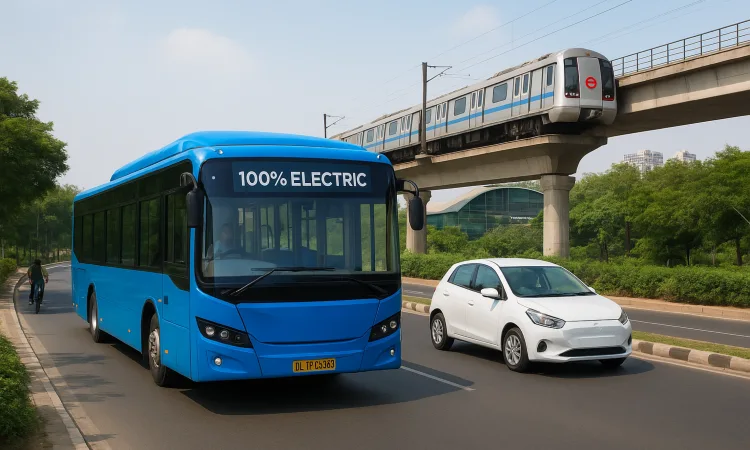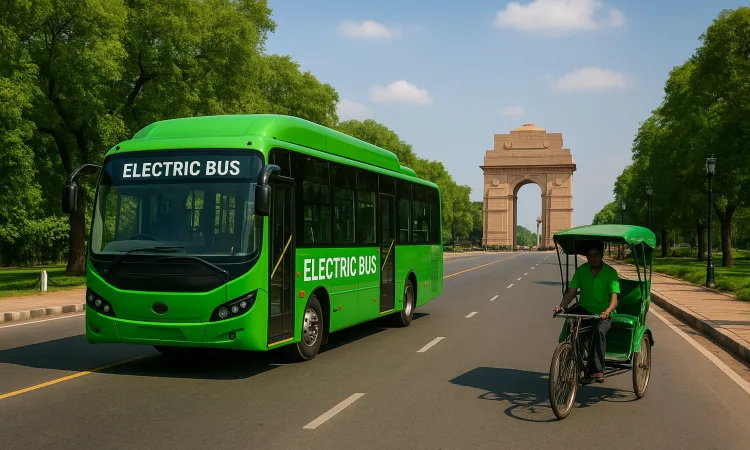|
Getting your Trinity Audio player ready...
|
Delhi is changing the way people travel. For years, the city has struggled with traffic jams, polluted air, and long travel times. But now, a wave of green transport initiatives is giving Delhi a cleaner, faster, and smarter future. From electric buses to the expanding metro and the rising use of electric vehicles (EVs), the capital is proving that modern cities can grow while protecting the environment.
In this blog, we’ll explore the main green transport projects, their benefits, and how they are transforming everyday life for residents.
Why is Green Transport Important for Delhi?
Delhi’s roads carry millions of vehicles every day. This heavy traffic releases a huge number of harmful gases, making air quality one of the biggest challenges for the city. Green transport solutions, like electric vehicles, clean public transport, and better connectivity, help reduce pollution, save fuel, and make the city more comfortable for everyone.
Studies have shown that most daily trips in Delhi are short, less than 4 kilometers. This means that improving local transport like buses, e-rickshaws, and cycling tracks can create a big positive impact in a short time.
Delhi Metro – The Clean Backbone of the City’
The Delhi Metro has become the heart of the city’s public transport system. It moves millions of people every day, keeping thousands of cars and motorbikes off the roads. The metro uses advanced technology like regenerative braking, which saves electricity, and is steadily increasing its use of renewable energy.
With each expansion, the metro connects more neighborhoods, making it easier for people to choose public transport over private vehicles. This shift reduces congestion, lowers emissions, and saves travel time.
Benefits of the Delhi Metro:
- Reliable and punctual travel
- Lower cost compared to fuel-driven personal vehicles
- Reduced road traffic and pollution
- Safe and comfortable journeys
Electric Buses, A Quiet and Clean Upgrade
Delhi is adding hundreds of electric buses to its fleet. These buses run silently, produce zero tailpipe emissions, and offer a smoother ride compared to diesel or CNG buses. The government plans to phase out older buses and replace them with electric models in the coming years.
Some electric buses will also operate on inter-city routes, connecting Delhi with nearby cities like Haridwar, Jaipur, and Meerut. This means cleaner travel not only inside the city but also across the region.
Don’t Miss: The Impact of Seasonal Pollution on Daily Life in Delhi

Why Electric Buses Matter:
- Cleaner air in crowded areas
- Reduced noise pollution
- Better travel comfort for passengers
- Lower maintenance costs for the city
Electric Vehicle Policy – Powering the Future
In 2020, Delhi introduced an Electric Vehicle Policy to encourage people to choose EVs over petrol and diesel vehicles. The policy offers benefits like tax exemptions, purchase incentives, and support for charging station installation.
The long-term vision is to make electric vehicles the normal choice for personal and commercial use. New plans include limiting fossil-fuel two-wheelers in the future and providing extra incentives for e-two-wheelers and e-autos.
As more people buy EVs, charging stations are being set up in markets, housing societies, and along major roads. This expanding network will make owning an EV more practical and convenient.
E-Rickshaws and E-Autos – The Last-Mile Champions
For short distances and quick trips to metro stations, e-rickshaws and e-autos have become essential. They provide affordable and accessible last-mile connectivity. However, safety, battery quality, and charging infrastructure still need improvement.
By increasing the number of authorized charging points and ensuring proper driver training, these vehicles can become even more reliable and safe for passengers.
Odd–Even Scheme – Emergency Traffic Relief
During high pollution periods, Delhi sometimes implements the odd–even vehicle rule. Under this system, cars with odd and even registration numbers are allowed on the roads on alternate days. While it’s a temporary measure, it has shown a noticeable drop in traffic congestion and emissions when implemented.
Although it’s not a long-term solution, it highlights the role of traffic management in controlling pollution levels.
Smart Cards and Seamless Travel
The future of public transport in Delhi lies in making journeys smoother and more connected. A single smart card that works on buses, the metro, and other modes of transportation is being promoted. This makes travel easier, reduces the need for multiple tickets, and encourages more people to use public transport instead of personal vehicles.
When combined with well-planned bus routes, better bus shelters, and real-time tracking, this integration can make public transport more appealing than driving.
Don’t Miss: Is Delhi Still Livable A Deep Dive into Air, Space, and Sanity
Benefits of Green Transport for Residents
Switching to green transport options benefits not just the environment but also daily life for citizens.
Key benefits include:
- Cleaner air: Reduced pollution means fewer health problems like asthma and respiratory issues.
- Lower costs: Public transport and EVs are cheaper to run compared to petrol and diesel vehicles.
- Time savings: Less traffic means faster travel times.
- Less noise: Electric vehicles create quieter streets, especially in residential areas.
- Better quality of life: A cleaner, quieter city is healthier and more pleasant to live in.
Challenges That Still Remain
While progress is clear, there are still challenges that need attention:
- Charging Infrastructure: Safer and reliable charging points are needed across the city.
- First- and Last-Mile Gaps: Better integration between transport modes is necessary to cover short distances.
- Fleet Upgrades: Continued replacement of old buses and autos with electric versions is essential.
- Public Awareness: Launching more campaigns to educate people about the benefits of green transportation can help boost adoption.
How You Can Contribute?
Residents and businesses have an important role to play in this transition:
- Choose public transport for daily commutes whenever possible.
- If buying a new vehicle, consider an electric option.
- Support safe and authorized charging setups in your community.
- Use last-mile options like e-rickshaws to connect with metro and bus stations.
- Spread awareness about the benefits of cleaner transport.
Wrapping Up
Delhi’s green transport initiatives are a sign of hope for a city that has long battled pollution and traffic chaos. The combination of an expanding metro, a growing fleet of electric buses, a strong EV policy, and better last-mile connectivity is transforming the way people move.
The road ahead will require consistent policies, better infrastructure, and active public participation. If the current pace continues, Delhi can become a cleaner, quieter, and more connected city, setting an example for other urban centers in India.
The journey has already begun, and with each new electric bus, metro line, and charging station, the future of Delhi’s transport is looking brighter.

